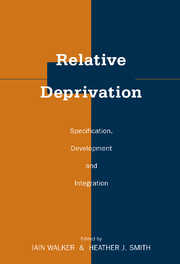Book contents
- Frontmatter
- Contents
- List of Contributors
- 1 Fifty Years of Relative Deprivation Research
- PART ONE SPECIFICATION
- PART TWO DEVELOPMENT
- 6 Personal and Group Relative Deprivation: Connecting the ‘I’ to the ‘We’
- 7 “Poisoning the Consciences of the Fortunate”: The Experience of Relative Advantage and Support for Social Equality
- 8 The Embeddedness of Social Comparison
- 9 Japanese and American Reactions to Gender Discrimination
- 10 Collective Action in Response to Disadvantage: Intergroup Perceptions, Social Identification, and Social Change
- PART THREE INTEGRATION
- Part Four Conclusion
- Index
10 - Collective Action in Response to Disadvantage: Intergroup Perceptions, Social Identification, and Social Change
Published online by Cambridge University Press: 29 September 2009
- Frontmatter
- Contents
- List of Contributors
- 1 Fifty Years of Relative Deprivation Research
- PART ONE SPECIFICATION
- PART TWO DEVELOPMENT
- 6 Personal and Group Relative Deprivation: Connecting the ‘I’ to the ‘We’
- 7 “Poisoning the Consciences of the Fortunate”: The Experience of Relative Advantage and Support for Social Equality
- 8 The Embeddedness of Social Comparison
- 9 Japanese and American Reactions to Gender Discrimination
- 10 Collective Action in Response to Disadvantage: Intergroup Perceptions, Social Identification, and Social Change
- PART THREE INTEGRATION
- Part Four Conclusion
- Index
Summary
Between May and August 1981, ten Irish Republicans imprisoned in the H-Block of the Long Kesh prison in Northern Ireland starved to death in a hunger strike. Their demands were quite simple. They wanted to be recognized not as criminals, but rather as political prisoners. They wanted their cause to be recognized as a political cause and their actions – which the British government described only as criminal – to be recognized as political acts designed to achieve changes that they believed would improve the status and treatment of their group. Their protest rallied the support of much of the Catholic community in Northern Ireland and drew international attention and sympathy for the prisoners and their cause. However, Margaret Thatcher and the British government remained unmoved in their opposition to the prisoners' demands and each of the ten young men suffered a slow and painful death. Although the British government never admitted to having conceded to the demands of the hunger-strikers, many of the privileges normally granted only to political prisoners were subsequently given to other Irish Republicans in prisons in Northern Ireland. But more important perhaps, the Hunger Strike of 1981 remains a pivotal moment in conflict in Northern Ireland (see Feehan, 1983; Sands, 1981).
How can we explain the actions of Bobby Sands and his fellow prisoners? Although a complete answer to this question is certain to be complex and multifaceted, in this chapter we will consider some of what social psychology can contribute to that answer.
- Type
- Chapter
- Information
- Relative DeprivationSpecification, Development, and Integration, pp. 200 - 236Publisher: Cambridge University PressPrint publication year: 2001
- 14
- Cited by



